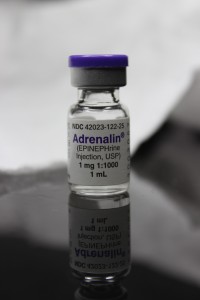Lit of the Week – 4/26/16
SOAP II: Comparison of Dopamine and Norepinephrine in the Treatment of Shock
De Backer D, Biston P, Devriendt J, Madl C, Chochrad D, Aldecoa C, Brasseur A,
Defrance P, Gottignies P, Vincent JL; SOAP II Investigators. Comparison of
dopamine and norepinephrine in the treatment of shock. N Engl J Med. 2010 Mar
4;362(9):779-89. doi: 10.1056/NEJMoa0907118. PubMed PMID: 20200382
Clinical question / background:
- Dopamine and norepinephrine are both first-line agents in the treatment of shock. Smaller studies had shown dopamine was independently associated with increased mortality. In a large randomized clinical trial, how does dopamine compare to norepinephrine for prevention of all-cause mortality in the treatment of shock?
Design:
- Randomized, double-blind, multi-center trial
- 1679 patients with diagnosis of shock
- 821 in norepinephrine group
- 858 in dopamine group
- Inclusion: Adults (> 18 y/o) with shock requiring a vasoactive agent
- Shock definition:
- MAP <70 mmHg or systolic BP <100 despite adequate fluids (1L crystalloid or 500mL colloids)
- Unless CVP >12 or PCWP >14
- Signs of tissue hypoperfusion: mottled skin, altered mental status, urine output < 0.5 cc/kg/hr, lactate > 2 mmol/L
- Exclusion: < 18 y/o, already on vasopressor for > 4 hours, serious arrhythmia >160 bpm, brain dead patients
- Primary outcome: all cause mortality at 28 days
- Secondary outcomes: death in ICU, in hospital, 6-month mortality, 12-month mortality, number of days without need for organ support, time to attainment of hemodynamic stability, VS changes, adverse events
Intervention:
- Enrolled patients received either dopamine or norepinephrine titrated to maximum doses of 20 mcg/kg/min for dopamine or 0.19mcg/kg/min for norepinephrine to maintain MAP > 65 mm Hg
- If additional pressor required, open-label norepinephrine was used
- Dopamine not allowed to be used as open-label
- Inotropes as needed for supplementary support
- Stress dose steroids and other ICU interventions per treating physician preference
Results:
- Shock Subtypes
- Septic shock 62%
- Cardiogenic shock 17%
- Hypovolemic shock 16%
- All-cause mortality at 28 days
- Dopamine 52.5% vs. Norepinephrine 48.5% (OR 1.17; 95% CI 0.97-1.42; P=0.10)
- ICU death
- Dopamine 50.2% vs. Norepinephrine 45.9% (OR 1.19; 95% CI 0.98-1.44; P=0.07)
- Inpatient mortality
- Dopamine 59.4% vs. Norepinephrine 56.6% (OR 1.12; 95% CI 0.92-1.37; P=0.24)
- 6-month mortality
- Dopamine 63.8% vs. Norepinephrine 62.9% (OR 1.06; 95% CI 0.86-1.31; P=0.71)
- 12-month mortality
- Dopamine 65.9% vs. Norepinephrine 64.0% (OR 1.15; 95% 0.91-1.46; P=0.34)
- 28-day mortality among patients with cardiogenic shock increased in dopamine group compared with norepinephrine (P=0.03)
- No significant difference in mortality among those with septic and hypovolemic shock
- Arrhythmia
- Dopamine 24.1% vs. Norepinephrine 12.4% (P<0.001; NNH 9)
Take-home:
- In the treatment of shock, norepinephrine and dopamine compare similarly with respect to 28-day mortality, but dopamine is associated with an increased risk of arrhythmias
- In cardiogenic shock, dopamine is associated with higher mortality
- Higher heart rate with dopamine may contribute to ischemic events
Strengths:
- Well-designed, large trial
- Broad inclusion criteria
- Powered to detect difference for primary outcome
Limitations
- Open label norepinephrine was given if maximum dose of dopamine or norepinephrine was used which may have confounded results
- Unclear if the underlying cause of shock was treated appropriately
- Unclear how frequent supportive interventions (eg, intraaortic balloon pumps) were used
Real-World
- Norepinephrine first-line vasopressor therapy for treatment of septic shock
- Dopamine as an alternative vasopressor agent to norepinephrine only in highly selected patients (eg, patients with low risk of tachyarrhythmias and absolute or relative bradycardia)

